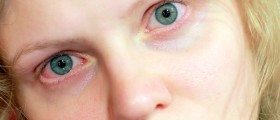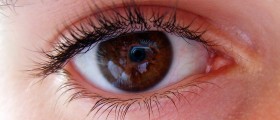
Neonatal conjunctivitis is inflammation of the conjunctiva that occurs only in newborn babies, hence the name.
Neonatal Conjunctivitis Causes
This medical condition is closely connected with a blocked tear duct. In this case tears cannot pass through the tear duct and this allows accumulation of infective agents which may at some point trigger infection.
Neonatal conjunctivitis also occurs due to different microorganisms found in the mother's vagina so that infection is actually contracted during vaginal delivery. Pregnant women who are suffering from sexually transmitted diseases (both bacterial or viral, especially if the infection is acute during delivery) are blamed for transmission of the infection onto their child. Such eye infections can be quite severe particularly if they are caused by Neisseria gonorrhoeae and Chlamydia trachomatis. Severe eye damage in newborns is also reported in case of Herpes simplex eye infection.
Neonatal Conjunctivitis Clinical Characteristics
The affected baby soon after the onset of infection starts to suffer from drainage from the eyes (eye discharge). The eyelids are red, edematous and tender to touch. The discharge is watery, pus-like and sometimes even bloody. It is quite simple to confirme the condition just by examining the baby's eyes. Still, in order for infective agents to be identified, doctors take samples of the discharge. Culture of the drainage will confirm the presence of the particular infective agents responsible for the infection.
Neonatal Conjunctivitis Treatment
In rare occasions when neonatal conjunctivitis is not infectious in origin and develops due to applications of some eye drops, the condition withdraws soon after discontinuation of these eye drops. There is no additional treatment necessary.
Infectious neonatal conjunctivitis, however, requires different approach and proper medicamentous treatment.
Babies in whom blocked tear duct triggers repeated conjunctivitis eventually overcome infection after probing. This procedure restores passability of the tear duct and allows tears to drain into the nasal cavity.
Bacterial neonatal conjunctivitis is treated with antibiotics. It is best to opt for antibiotics isolated bacteria are sensitive to. Bacterial sensitivity is confirmed with antibiogram. Antibiotics are administered in a form of ointment or eye drops.
Viral infections, on the other hand, can be brought under control with antiviral drugs also available in ointments and eye drops.
The outcome of neonatal conjunctivitis is good and the baby rarely develops some complications, out of which the most severe ones include blindness, perforation of the cornea and corneal scarring as well as inflammation of the iris.
Finally, it is possible to prevent neonatal conjunctivitis caused by sexually transmitted diseases if mother is properly treated prior vaginal delivery.

















Your thoughts on this
Loading...